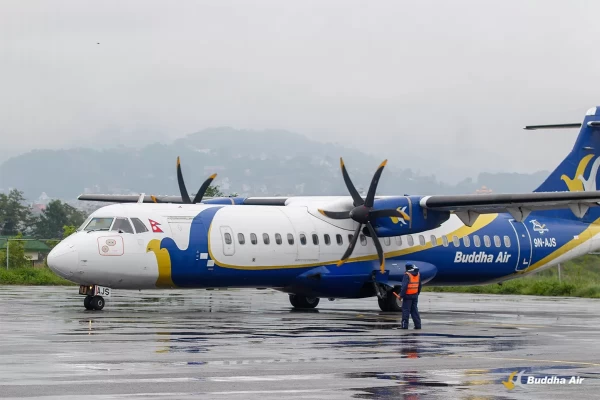Types of Fog Every Pilot Must Know to Navigate Safe Skies

Cloudy, disturbs your vision of the surroundings, and as cold as it could get–all of us can recognize fog when we see it on one of those early chilly winter mornings. But did you know, that a pilot has to study different types of fog and how to recognize them as a part of their training? In fact, understanding types of fog is closely associated with visibility, flight safety, and scheduling.
Fog is essentially a cloud that forms near the ground, reducing visibility to less than 1 kilometre. It typically forms when the air near the surface cools to its dew point or when moisture is added to the air. However, not all fog is the same, and its characteristics vary depending on how and where it forms.
What is Fogging in Aviation?
Fogging in aviation refers to the formation of fog near airports, runways, or flight paths, which can severely impact visibility and disrupt operations. For instance, low visibility due to fog can lead to flight delays, diversions, or cancellations. It then demands pilots to rely more heavily on their instruments rather than visual cues. Pilots must be able to understand the types of fog aviation as each type presents its own challenges and requires different strategies for safe navigation.
In addition, fog’s effect is not limited to takeoff and landing. It also impacts air traffic control operations and the efficiency of airport ground services. For example, thick fog can necessitate increased separation between aircraft during takeoff or landing, reducing airport capacity.
Types of Fog and How They Form
Fog can be classified into several types based on its formation process. Here are the most common types of fog pilots in Nepal are likely to encounter.
1. Radiation Fog
This type of fog forms on clear, calm nights when the ground loses heat through radiation, cooling the air near the surface to its dew point. Radiation fog is most common in valleys or low-lying areas and usually dissipates after sunrise as the ground warms up. It poses a significant risk during early morning flights when visibility is reduced. Each of these types of fog aviation weather conditions comes with its own challenges, and pilots must be prepared to adapt their flight plans accordingly.
2. Advection Fog
Advection fog occurs when moist air moves over a cooler surface, causing the air to cool to its dew point. This type of fog is common along coastlines where warm, moist air from a waterbody moves over cooler land. Pilots must be cautious of advection fog and radiation fog, as both can develop rapidly and affect visibility.
3. Upslope Fog
Upslope fog forms when moist air is forced to rise along a slope or mountain, cooling as it ascends. This type of fog is often seen in hilly or mountainous regions of Nepal. For pilots flying in these areas, upslope fog can create hazardous conditions by obscuring terrain features. To avoid any unforeseen circumstances, sometimes it is best for pilots and Air Traffic Controllers to delay or cancel flights.
You may also read: Air Traffic Control (ATC): How It Ensures Safe Skies
4. Steam Fog
Steam fog, also known as sea smoke, forms when cold air moves over warm water. The warm water evaporates into the cold air, increasing the moisture content and forming fog. This type is common in polar regions or during winter months near lakes and rivers, again, much more common in any land topography as that of Nepal.
5. Ice Fog
Ice fog forms in extremely cold temperatures, typically below –30°C (–22°F), when water vapour sublimates directly into ice crystals. It is most commonly seen in polar regions or high-altitude locations, especially in the mountainous region and upper-hilly region during core winter times in Nepal. Ice fog is particularly dangerous for aviation as it can contribute to ice accumulation on aircraft surfaces.
How Do Fogs Affect the Flight?
Fog significantly impacts flight operations in many ways.
Reduced Visibility
The primary challenge fog poses is reduced visibility. During dense fog, pilots may not be able to see the runway until the final stages of landing. This makes precision instrument landing systems (ILS) that are required for safe operations.
Impact on Takeoff and Landing
Takeoff and landing are the most critical phases of flight, and fog increases the complexity of these operations. Airports often impose strict visibility minimums during foggy conditions. If the visibility drops below these limits, flights may be delayed, diverted, or cancelled.
Disruption to Air Traffic Control
Fog reduces the efficiency of air traffic control systems, as controllers must increase the separation between aircraft to ensure safety. This can lead to congestion and delays.
Ground Operations
Fog affects ground operations by reducing the visibility of taxiways, ramps, and runways. Ground vehicles and personnel may also face challenges in locating aircraft or maintaining schedules.
Aircraft Performance
In some cases, fog can lead to the accumulation of moisture or ice on the aircraft, impacting its aerodynamics. Pre-flight anti-icing and de-icing measures become essential in such conditions.
FAQs about Fog
What are Advection Fog and Radiation Fog?
Advection fog forms when warm, moist air moves over a cooler surface, cooling the air to its dew point. Radiation fog, on the other hand, forms on clear, calm nights when the ground loses heat, cooling the air above it to its dew point.
What is Fogging in Aviation?
Fogging in aviation refers to the presence of fog in areas critical to flight operations, such as runways and flight paths. It affects visibility and requires pilots to rely on instruments for safe navigation.
What is Fog Type?
Fog type refers to the specific category of fog based on its formation process. Examples include radiation fog, advection fog, upslope fog, steam fog, and ice fog.
